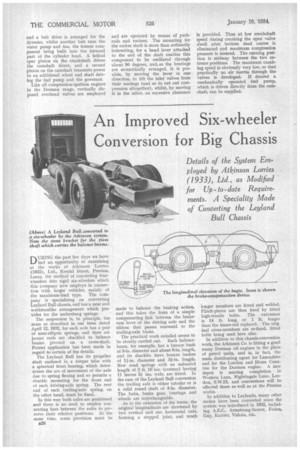An Improved Six-wheeler Conversion for Big Chassis
Page 36

If you've noticed an error in this article please click here to report it so we can fix it.
Details of the System Employed by Atkinson Lorries (1933), Ltd., as Modified for Up to date Requirements. A Speciality Made of Converting the Leyland Bull Chassis
DURING the past few days we have had an opportunity of examining at the works of Atkinson Lorries (1932), Ltd., Kendal Street, Preston, Lanes, the method of converting fourwheelers into rigid six-wheelers which this company now employs in connection with larger vehicles, mainly of the maximum-load type. The company is specializing on converting Leyland Bull chassis, and has a neat and workmanlike arrangement which provides for the underslung springs.
The suspension is, in principle, the same as described in our issue dated April 12, 1932, for each axle has a pair of semi-elliptic springs, and their adjacent ends are shackled to balance beams pivoted on a cross-shaft. Patent application has been made in regard to certain of the details.
The Leyland Bull has its propeller shaft enclosed in a torque tube with a spherical front bearing, which determines the arc of movement of the axle due to spring flexing and so permits a shackle mounting for the front end of each driving-axle spring. The rear end of each trailing-axle spring, on the other hand, must he fixed.
In this way both axles are positioned and there is no need to employ connecting bars between the axles to preserve their relative positions. At the same time, some provision must be B26 made to balance the braking action, and this takes the form of a simple compensating link between the brakecam lever of the driving axle and the ribbon that passes rearwaid to the trailing-axle brake.
The practical work entailed seems to be stoutly carried out. Each balancebeam, for example, has a bronze bush of 3-in, diameter and about 6-in, length, and its shackles have bronze bushes of 1i-in. diameter and 3i-in. length. New road springs with an unloaded length of 3 ft. 10 ins. (centres) having 11 leaves n ins, wide, are fitted. In the case of the Leyland Bull conversion the trailing axle is either tubular or is a solid round shaft of 4-in. diameter. The hubs, brake gear, bearings and wheels are interchangeable.
As to the extension of the frame, the original longitudinals are shortened by two vertical and one horizontal cuts, forming a stepped joint, and much longer members are fitted and welded. Flitch-plates are then fixed by fitted high-tensile bolts. The extension is 14 ft. long, or 1 ft. longer than the frame-tail replaced. The original cross-members are re-fixed, fitted bolts being used here also.
In addition to this chassis-conversion work, the Atkinson Co. is fitting a good many Dorman oil engines in the place of petrol units, and is, in fact, the main distributing agent for Lancashire and for the London and Home Counties for the Dorman engine. A new depot is nearing completion in Western Lane, Nightingale Lane, London, S.W.12, and conversions will be effected there as well as at the Preston works.
In addition to Leylands, many other makes have been converted since the system was introduced in 1932, including A.E.C., Armstrong-Saurer, Foden, Guy, Karrier, Vulcan, etc.




















































































